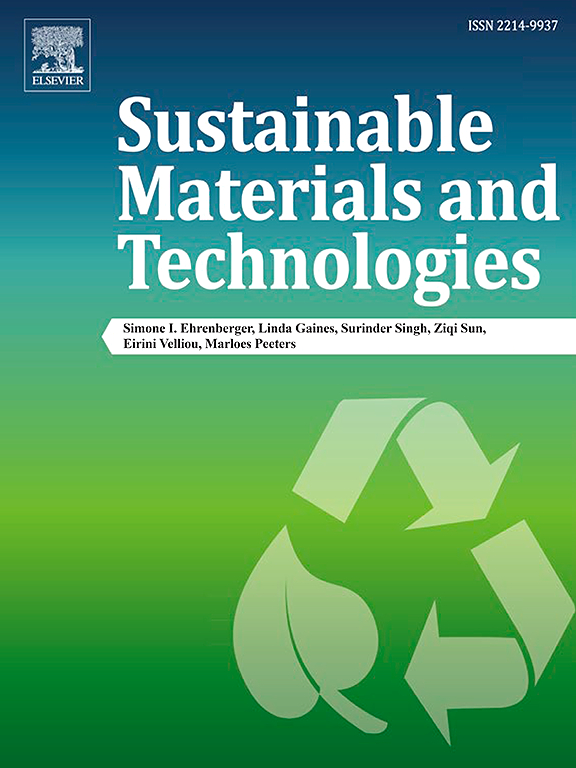Life cycle assessment and hot spot analysis of concrete repair principles and application on life cycle intervention strategies
IF 8.6
2区 工程技术
Q1 ENERGY & FUELS
引用次数: 0
Abstract
The combination of continually deteriorating reinforced concrete structures and environmental objectives calls for sustainable repair and maintenance interventions. To respond to this need, the environmental impact of life cycle intervention strategies of reinforced concrete structures to restore and prevent corrosion damage is analysed through a life cycle assessment (LCA). First, the dominant midpoint impact categories, related to these interventions, are identified as (1) carcinogenic human toxicity, (2) global warming potential (3) fine particulate matter formation, (4) freshwater ecotoxicity, (5) non-carcinogenic human toxicity and (6) marine ecotoxicity. Secondly, a comprehensive assessment is performed for reference flow activities related to the EN1504–9 principles in order to get more insight into this data before case dependencies are applied. Based on this, the hotspots per category and even per activity could be determined. In general, the production and gross End-of-Life (EoL)-phase are the important life cycle phases. Finally, the activities and principles are combined to achieve actual intervention strategies applied on a case study of a reinforced concrete bridge. The outcomes show the dominance of carcinogenic human toxicity resulting in a high impact for demolishing and rebuilding. Although this scenario scores well for other midpoints, alternative interventions like impressed current cathodic protection score well in general. So, the interventions patch repair, conventional repair, galvanic cathodic protection, chloride extraction and realkalisation perform less well on average. Nevertheless, for specific midpoints or service life extensions they could still have a lower impact, like patch repair for a 20-year service life. In addition, the production and gross EoL-phase are also the most important for the case study. Secondly, when looking at the type of work, the main intervention but also the reinforcement preparation, concrete preparation and concrete surface protection are dominant.
混凝土修复的全生命周期评价与热点分析及其在全生命周期干预策略中的应用
持续恶化的钢筋混凝土结构与环境目标相结合,要求采取可持续的维修和维护干预措施。为了满足这一需求,我们通过生命周期评估(LCA)分析了钢筋混凝土结构的生命周期干预策略对环境的影响,以修复和防止腐蚀损坏。首先,确定了与这些干预措施相关的主要中点影响类别:(1) 致癌人体毒性;(2) 全球变暖潜势;(3) 细颗粒物的形成;(4) 淡水生态毒性;(5) 非致癌人体毒性;(6) 海洋生态毒性。其次,对与 EN1504-9 原则相关的参考流活动进行综合评估,以便在应用案例依赖性之前对这些数据有更深入的了解。在此基础上,可以确定每个类别甚至每项活动的热点。一般来说,生产阶段和生命周期末期(EoL)阶段是重要的生命周期阶段。最后,将这些活动和原则结合起来,在钢筋混凝土桥梁的案例研究中实现实际的干预策略。研究结果表明,致癌的人体毒性占主导地位,对拆除和重建造成很大影响。虽然这一方案在其他中点上得分较高,但其他干预措施(如印象电流阴极保护)总体上得分较高。因此,修补修复、传统修复、电化学阴极保护、氯化物提取和重新碱化等干预措施的平均得分较低。尽管如此,对于特定的中点或使用寿命的延长,它们的影响仍然较小,例如对于 20 年使用寿命的修补修复。此外,在案例研究中,生产阶段和总的 EoL 阶段也是最重要的。其次,从工程类型来看,主要干预措施以及钢筋准备、混凝土准备和混凝土表面保护都是主要的。
本文章由计算机程序翻译,如有差异,请以英文原文为准。
求助全文
约1分钟内获得全文
求助全文
来源期刊

Sustainable Materials and Technologies
Energy-Renewable Energy, Sustainability and the Environment
CiteScore
13.40
自引率
4.20%
发文量
158
审稿时长
45 days
期刊介绍:
Sustainable Materials and Technologies (SM&T), an international, cross-disciplinary, fully open access journal published by Elsevier, focuses on original full-length research articles and reviews. It covers applied or fundamental science of nano-, micro-, meso-, and macro-scale aspects of materials and technologies for sustainable development. SM&T gives special attention to contributions that bridge the knowledge gap between materials and system designs.
 求助内容:
求助内容: 应助结果提醒方式:
应助结果提醒方式:


